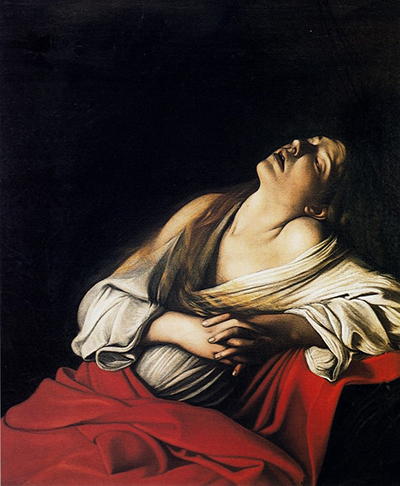The painting called Mary Magdalene in Ecstasy was created by Caravaggio, an Italian painter, in 1606. The piece of art depicts a very famous story about Magdalene's redemption.
It's said that the woman was living isolated in the southern France near Aix-en-Provence, after Christ's death. And the remarkable moment painted by Caravaggio refers to harmonies played by celestial angels that Magdalene could hear seven times a day. So this is where the ecstasy word comes from since this deeply afflicted woman could hear melodies from heaven that gave peace to her soul. The painting is very different from others that refer to Magdalena's ecstasy because Caravaggio had a particular realistic style. Instead of showing angels and a naked Magdalena he preferred to keep his earth-bound version and the astonishing tenebrism technique. With such technique, the Italian painter used shadows to highlight lighter areas, almost playing with dark and light.
The body of Magdalena is coloured with varying tones, indicating a light coming from above. Her wrists are strong, fingers are crossed, her head is fallen back against a dark background and at the same time, she has a unique expression, delighted with the angels' harmonies. This piece of art certainly shows Caravaggio's style. The painter whose name was Michelangelo Merisi was ahead of his time and his realistic vision about sacred scenes gave him both fame and disapproval by Catholic patrons. Because of his aggressive behaviour and short temper he was frequently involved in quarrels and fights. And by the time he painted Mary Magdalena in ecstasy he had killed a man and was hiding from authorities. He actually had a short life, living from 1571 to 1610.
Until then, only copies of Mary Magdalene in ecstasy could be seen. However, the original painting was found in 2014, recognized by Mina Gregori, a scholar and expert in Caravaggio's style. She recognized the 100 by 90 cm oil canvas immediately, because according to her, the features were undoubtedly a Caravaggio's creation. The painting is a property of a family from Europe and currently, they don't intend to sell it. Another detail that convinced Mina to be in front of the original piece of art was the handwritten note attached to the back of the canvas, saying the painting was a Caravaggio's work, created for one of his main patrons, the Cardinale Scipione Borghese of Rome. Maybe one day, the family from Europe will allow the world to appreciate such a splendid piece of art.




